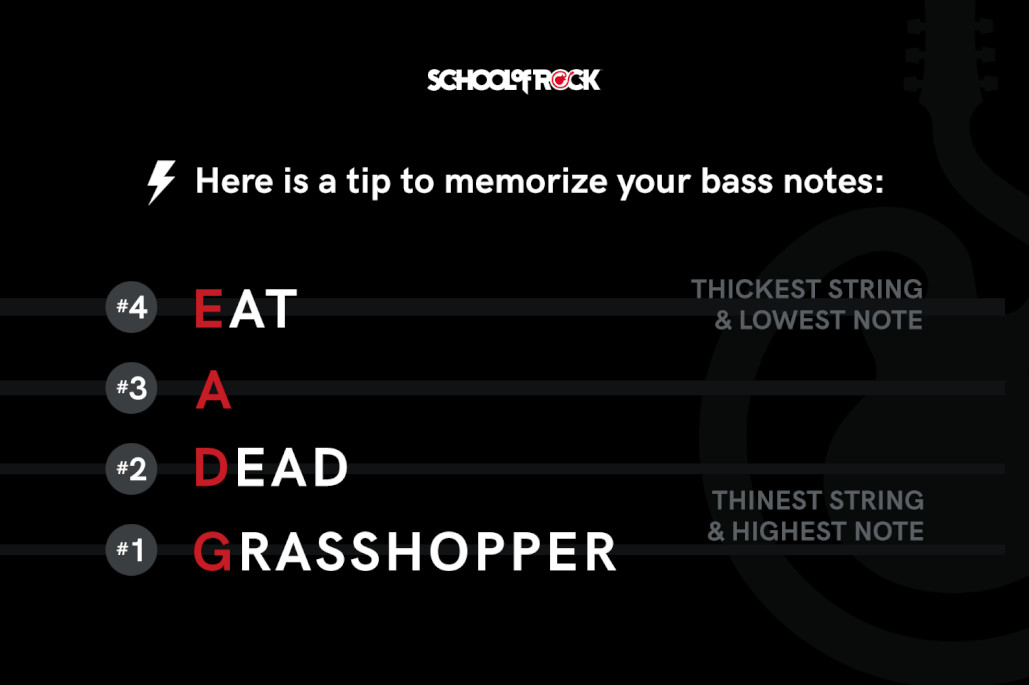Learning the names of the strings on a bass guitar is fundamental for any aspiring bassist. Just like knowing the alphabet is key to reading, understanding the names of your bass strings is the first step to tuning, playing, and truly mastering your instrument. Without properly tuned strings, your bass won’t sound its best, and your practice sessions won’t be as effective or enjoyable. Getting to grips with the Names Of Strings On A Bass Guitar is essential, whether you’re jamming by yourself or playing with a band.
Understanding the Standard 4-String Bass Guitar String Names
The most common type of bass guitar is the 4-string bass. These four strings, when tuned to standard tuning, are named E, A, D, and G. This sequence, from the thickest string to the thinnest, represents the standard tuning for a 4-string bass. Think of it this way: the thickest string, closest to your head when you play, is the E string, and they get progressively higher in pitch as they get thinner, moving through A, D, and finally G, the thinnest string.
To help remember the order of these string names, many bass players use a mnemonic phrase. A popular one is “Eat Apples Don’t Go”. This catchy phrase can make memorizing the string names much easier, especially when you’re just starting.
It’s also helpful to understand how bass guitar strings relate to a standard 6-string guitar. The 4 strings of a bass guitar are the same notes as the lowest four strings on a guitar – E, A, D, and G – but tuned one octave lower. This lower octave is what gives the bass guitar its deep, foundational sound in music.
 Bass guitar notes are E, A,D, and G
Bass guitar notes are E, A,D, and G
Image alt text: The names of the four strings on a standard bass guitar are shown as E, A, D, and G, representing the standard bass guitar string notes.
Knowing these names isn’t just about memorization; it’s about understanding the fundamental building blocks of bass playing. When someone refers to the “E string,” you’ll immediately know which string they are talking about. This knowledge becomes crucial when learning bass tabs, chord shapes, and communicating with other musicians.
Exploring String Names on 5 and 6-String Bass Guitars
As you progress in your bass playing journey, you might encounter bass guitars with more than four strings. 5-string and 6-string basses offer extended ranges and tonal possibilities. Understanding the string names on these basses is a natural extension of knowing the standard 4-string names.
5-String Bass Guitar String Names
A 5-string bass typically adds an extra low string. The most common tuning for a 5-string bass is B, E, A, D, G. Notice that this adds a B string below the standard E string, providing a lower tonal range. This low B string is particularly useful in heavier genres of music and provides a deeper, richer sound.
Some 5-string basses are tuned with a high C string instead of a low B, resulting in E, A, D, G, C tuning. This configuration expands the higher range of the bass. However, the low B tuning (B, E, A, D, G) is far more prevalent.
6-String Bass Guitar String Names
For bassists seeking the widest possible range, the 6-string bass combines both the low B and high C strings. The standard tuning for a 6-string bass is B, E, A, D, G, C. This gives you the full spectrum, extending both lower and higher than a standard 4-string bass. While 6-string basses offer incredible versatility, they can be more challenging to play initially due to the wider neck and closer string spacing.
Understanding the names of strings on 5 and 6-string basses builds directly upon your knowledge of the 4-string bass. It’s simply a matter of adding strings either below the E string (for lower range) or above the G string (for higher range), while retaining the core E, A, D, G string names.
String Names and Bass Guitar Tuning Methods
Knowing the names of your bass strings is intrinsically linked to tuning your instrument. Whether you are tuning by ear, using an electronic tuner, or a tuner app, you are always tuning to specific string names.
When using an electronic tuner or app, you will typically see the string names displayed (E, A, D, G, etc.). The tuner detects the pitch of the string you are playing and indicates whether it is sharp (too high), flat (too low), or in tune for the target string name. Understanding the names allows you to correctly identify which string you are tuning and ensures you are aiming for the right pitch.
If you are tuning by ear, perhaps using a reference pitch from another instrument or a tuning fork, knowing the string names is even more crucial. You need to be able to recognize the correct pitch for each string name and adjust your tuning pegs until your bass string matches that pitch.
 tip to memorize your bass notes Eat A Dead Grasshopper
tip to memorize your bass notes Eat A Dead Grasshopper
Image alt text: A helpful mnemonic phrase, “Eat A Dead Grasshopper,” is presented as a tip to memorize the names of the bass string notes E, A, D, and G.
Effectively, the names of the strings on a bass guitar are the targets you are aiming for when tuning. Without knowing these names, tuning becomes a much more abstract and difficult process.
String Gauges and Their Impact on Tone
While the names of the strings (E, A, D, G, etc.) define their pitch, the physical strings themselves also have different characteristics. One important aspect is string gauge, which refers to the thickness of the string. Bass strings come in various gauges, and these gauges are directly related to the string names and the overall tone of your bass.
Generally, the lower the string name (like the low B on a 5-string bass), the thicker the string gauge needs to be to achieve the correct pitch and resonance at that lower frequency. Thicker strings produce a fuller, deeper tone, often preferred for genres like rock and metal. Thinner gauge strings, while still thicker than guitar strings, can offer a brighter, snappier tone, suitable for genres like funk or jazz.
When you buy bass strings, they are often sold in sets designed for standard tunings (like E, A, D, G for 4-string basses). These sets will have appropriately gauged strings for each string name to ensure balanced tension and tone across your bass. Understanding string names helps you choose the right string sets for your bass and desired sound.
Maintaining Your Bass Guitar Strings and Tuning
Once you have learned the names of the strings on your bass guitar and have them properly tuned, you’ll want to keep them sounding their best for as long as possible. Regular maintenance will not only prolong the life of your strings but also help your bass stay in tune longer.
Changing your strings periodically is essential. Over time, bass strings can lose their brightness and become harder to keep in tune. How often you change strings depends on how much you play and your personal preference. If you play frequently, you might want to change them every month or two.
Keeping your strings clean is another simple but effective maintenance tip. Wipe down your strings after each playing session to remove sweat and oils, which can corrode the strings and dull their tone. Washing your hands before playing also helps keep your strings cleaner for longer.
Finally, storing your bass in its case when not in use will protect it from temperature and humidity fluctuations, which can affect tuning stability. Consistent temperature and humidity are beneficial for keeping your bass strings in tune.
Get Ready to Play
Understanding the names of the strings on your bass guitar is a crucial first step in your musical journey. It unlocks the door to tuning, learning songs, and communicating with other musicians. By knowing the names – E, A, D, G, and extending to B and C for 5 and 6-string basses – you have established a fundamental understanding that will support your bass playing for years to come. Now that you know the basics, pick up your bass, tune those strings, and start playing!
